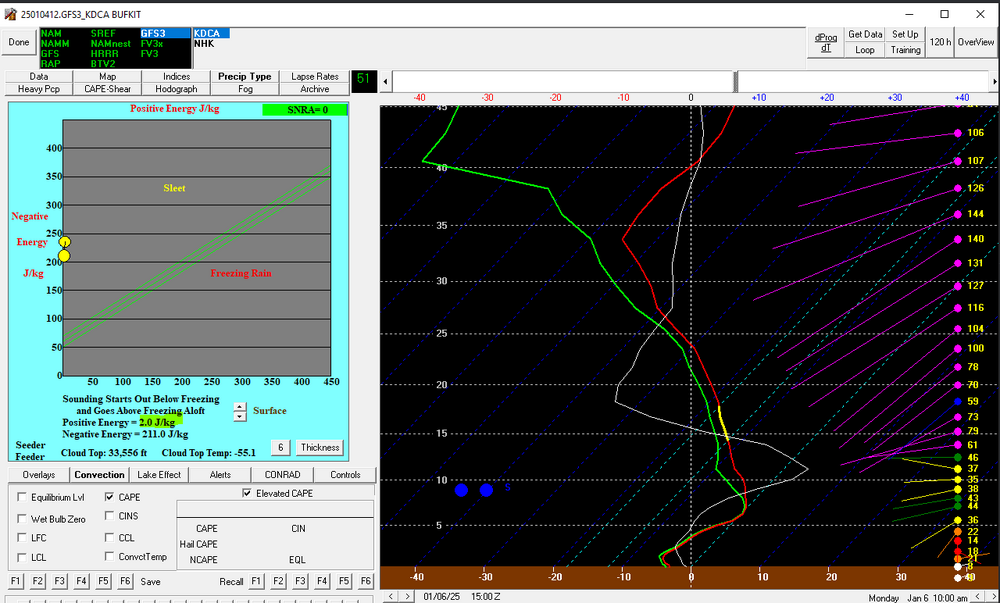-
Posts
5,571 -
Joined
-
Last visited
Content Type
Profiles
Blogs
Forums
American Weather
Media Demo
Store
Gallery
Everything posted by csnavywx
-

Southern MD / Lower Eastern Shore weather discussion
csnavywx replied to PrinceFrederickWx's topic in Mid Atlantic
Flipped back to all snow 20m after this. Piling up quick on this last push. -

Southern MD / Lower Eastern Shore weather discussion
csnavywx replied to PrinceFrederickWx's topic in Mid Atlantic
About as expected. Is nice to see some fight on the transition line though. 30% sleet and 70% enormous aggregates of snow. Absolutely dumping. -

Southern MD / Lower Eastern Shore weather discussion
csnavywx replied to PrinceFrederickWx's topic in Mid Atlantic
Flipped to sleet about 45m ago. Now over to a rare sleet/snow/freezing rain mix. -
Getting some quarters and half dollars under these enhanced echoes. Made of basically pure dendrites.
-

Southern MD / Lower Eastern Shore weather discussion
csnavywx replied to PrinceFrederickWx's topic in Mid Atlantic
Heavy snow arriving under the main band. Lots of smaller dendrites with enormous chonkers mixed in -- some quarters and half-dollar aggregates made of almost pure dendrites. Very efficient snowmaking going on. Piling up fast now. -
Up to about 1/2" down here. Light to borderline moderate snow.
-
Yes. It's the radar beam hitting the precip further up as the beam travels up and away from the point of origin. Precip started down here when the ceiling got down to ~3k ft. Ceilometers are useful right now!
-
Light snow commenced here at 11:15pm. Started as tiny flakes with small aggregates mixed in. Quickly picked up in intensity and is now approaching moderate. Good coating already.
-

Southern MD / Lower Eastern Shore weather discussion
csnavywx replied to PrinceFrederickWx's topic in Mid Atlantic
Light snow commenced here at 11:15p. Tiny flakes with a few partially evaporated small aggregates mixed in. -

Southern MD / Lower Eastern Shore weather discussion
csnavywx replied to PrinceFrederickWx's topic in Mid Atlantic
High chance there's some mixing as we get towards mid-morning. Saving grace is if we somehow get a decent E-W mesoscale band to set up around the mixing line and feed off the melting-induced gradient. Thinking 5-7" for you and me. -

Southern MD / Lower Eastern Shore weather discussion
csnavywx replied to PrinceFrederickWx's topic in Mid Atlantic
I think they prob. mix with sleet a bit too much/early to be the jackpot area. Unless some wild mesoscale melt-enhanced band can set up. -

Southern MD / Lower Eastern Shore weather discussion
csnavywx replied to PrinceFrederickWx's topic in Mid Atlantic
Prob not as much as just further south. I'd have to break out the soundings but my first guess there would be 6-8" with sleet mixing in around 10am-noon tomorrow. -

Southern MD / Lower Eastern Shore weather discussion
csnavywx replied to PrinceFrederickWx's topic in Mid Atlantic
Gonna do some BUFKIT profiles and post em here this evening as we progress. -

Southern MD / Lower Eastern Shore weather discussion
csnavywx replied to PrinceFrederickWx's topic in Mid Atlantic
We always have issues with mixing in WAA/WCB setups and I don't expect this time to be different. The two things we have going for us is that the precip arrives before the surface high/ridge even leaves, so that cold air won't get shoved out immediately. The second is that the wave has a nice flat track so the WCB will be more elevated in the column initially. This gives us a couple of chances to cash in on decent accumulations before thermals become prohibitive. Once with the initial shove of elevated WAA (around 700mb) this evening and then initially with surge of moisture and warm advection in the main WCB early in the morning. I've been watching upstream stations and the transition zone has been fairly narrow, so the southern cutoff with decent snow accumulations to an overabundance of sleet is going to be pretty sharp. Easton may do fairly well here while places like here in Lexington Park to Salisbury mix significantly with sleet. This is also a scenario where dynamics around melting can enhance an east-west band for a few hours. Regardless of the WAA driven stuff, I do expect the favorable track of the 500/700mb vort will provide an inch or two of snow on the backside to those of us who get skunked by a sleet-fest. -
I think in this particular case -- it's less to do with the thermal profile and more to do with the fact that it's unsaturated below -10C in the cloud layer. Lack of ice crystals preventing any sort of nucleation.
-
It's also open at H5 vs. GFS which keeps it closed for a while longer. Makes a difference to the WCB.
-
Needs to be >10 J/kg or the hydrometeors won't melt. Verbatim it's still snow. The real issue is the dry slot impinging aloft around this time, which starts removing most of the ice crystals. Snow growth gets inefficient or flips to snow grains and/or freezing drizzle until around 5pm, when the IC layer is restored as the main vort maxes passes south.
-
Really comes down to who is handling the H5/H7 features better here. GFS opens the upper low later than the EC and as a result has a more coherent WCB and warm nose, which ends up causing p-type issues but makes up for it somewhat with a stronger backside as the H5/7 vort maxes slide just south. The tracks and timing are otherwise basically the same. Either way, there should be some banding along/just left of the mid-level vort maxes.
-
I love these little systems. They tend to outperform. Quite a few lightning strikes now showing up on my display (14 in last 10m or so).
-
Temps ahead of the trough/front will be pretty mild (u30-l40s), but given the very cold temps aloft and the borderline convective setup right along the boundary, I would expect temps to drop pretty quickly as precip arrives. Convective overturning is in play here.
-
1/2" hail and plenty of lightning. Gusts to around 40mph. Very solid mid-winter thunderstorm. Probably the strongest cold season storm I've gotten since I've lived here.
-

Southern MD / Lower Eastern Shore weather discussion
csnavywx replied to PrinceFrederickWx's topic in Mid Atlantic
Two legit chances here. First with the clipper-type system on Fri, which could produce a brief, but stout band or two and the front-end of Monday's system, provided the wave doesn't get sheared out too quickly or suppressed too much. -
Wouldn't sleep on this one. Nice trop fold, very weakly stable to moist neutral atmosphere as it moves in, strong digging mid-level (500mb) jet streak, and a favorable position of mid/upper features. Lack of decent low-level/surface reflection and a relatively dry boundary layer due to weak return flow are cons.
-
Land carbon sink stability (particularly in tropical rainforests and now in the Arctic) is now at serious risk: https://www.woodwellclimate.org/2024-arctic-report-card-tundra-net-source-carbon/ This comes as a significant jump in warming has occurred in the last ~10y. It seems increasingly likely that the existing stock of land plant and soil carbon just isn't stable at these temperatures. The one that worries me the most is South America and southern Africa as asymmetric NH warming causes the ITCZ to migrate northward. Respiration driven losses in those areas combined with outgassing and burning permafrost land (esp. peat) could conceptually eventually cancel out the global land carbon sink in general if it keeps going the way it is.
-
The fact that we're just going to gap straight up almost as much as we did last year (off of '16) is crazy. CERES imbalance has finally been reacting since spring and coming down off the dizzying heights of '23 though, so we *should* see some consolidation or retracement on the chart over the next few years. One would hope anyways. If the imbalance starts working its way back up without much temp retracement though, that's going to be a world of hurt.




